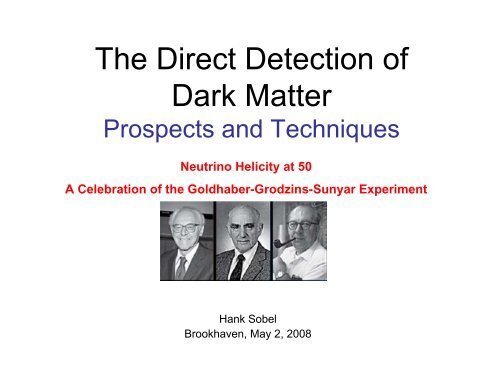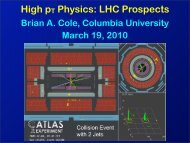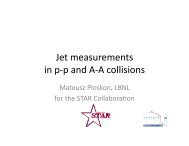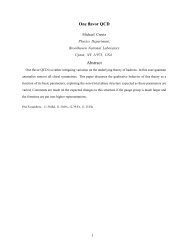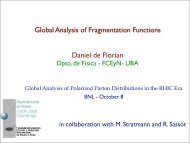Prospects for the Direct Detection of Dark Matter - BNL theory groups
Prospects for the Direct Detection of Dark Matter - BNL theory groups
Prospects for the Direct Detection of Dark Matter - BNL theory groups
Create successful ePaper yourself
Turn your PDF publications into a flip-book with our unique Google optimized e-Paper software.
The <strong>Direct</strong> <strong>Detection</strong> <strong>of</strong><strong>Dark</strong> <strong>Matter</strong><strong>Prospects</strong> and TechniquesNeutrino Helicity at 50A Celebration <strong>of</strong> <strong>the</strong> Goldhaber-Grodzins-Sunyar ExperimentHank SobelBrookhaven, May 2, 2008
Background• In <strong>the</strong> past decade, breakthroughs in cosmologyhave trans<strong>for</strong>med our understanding <strong>of</strong> <strong>the</strong>Universe.• A wide variety <strong>of</strong> observations now support aunified picture in which <strong>the</strong> known particlesmake up only one-fifth <strong>of</strong> <strong>the</strong> matter in <strong>the</strong>Universe, with <strong>the</strong> remaining four-fifthscomposed <strong>of</strong> dark matter.• The evidence <strong>for</strong> dark matter is nowoverwhelming, and <strong>the</strong> required amount <strong>of</strong> darkmatter is becoming precisely known.2
Despite this progress, <strong>the</strong> identity <strong>of</strong>dark matter remains a mystery• Constraints on dark matter properties <strong>the</strong>bulk <strong>of</strong> dark matter cannot be any <strong>of</strong> <strong>the</strong>known particles.– One <strong>of</strong> <strong>the</strong> strongest pieces <strong>of</strong> evidence that <strong>the</strong>current <strong>the</strong>ory <strong>of</strong> fundamental particles and<strong>for</strong>ces, is incomplete.• Because dark matter is <strong>the</strong> dominant <strong>for</strong>m <strong>of</strong>matter in <strong>the</strong> Universe, an understanding <strong>of</strong>its properties is essential to attempts todetermine how galaxies <strong>for</strong>med and how <strong>the</strong>Universe evolved.– <strong>Dark</strong> matter <strong>the</strong>re<strong>for</strong>e plays a central role in bothparticle physics and cosmology, and <strong>the</strong> discovery<strong>of</strong> <strong>the</strong> identity <strong>of</strong> dark matter is among <strong>the</strong> mostimportant goals in basic science today.3
<strong>Dark</strong> <strong>Matter</strong>What We Know• How much:Ω DM = 0.23 ± 0.04• What it’s not:Not short-lived: τ > 10 10 yearsNot baryonic: Ω B = 0.04 ± 0.004Not hot: “slow” DM is requiredto <strong>for</strong>m structureWhat We Don’t know• Mass?• Spin?• O<strong>the</strong>r quantum numbers andinteractions?• Absolutely stable?• One particle species or many?• How produced?• When produced?• Why does Ω DM have <strong>the</strong> observedvalue?• Role in structure <strong>for</strong>mation?• How distributed now?4
The Properties <strong>of</strong> a Good <strong>Dark</strong><strong>Matter</strong> Candidate• stable (protected by a conservedquantum number)• no charge, no color (weakly interacting)• cold, non-dissipative• relic abundance compatible toobservation• motivated by <strong>the</strong>ory (vs. “ad hoc”)5
<strong>Dark</strong> <strong>Matter</strong> Candidates• The <strong>the</strong>oretical study <strong>of</strong> dark matter is verywell-developed, and has led to many concreteand attractive possibilities.• Two leading candidates <strong>for</strong> dark matter areAxions and weakly-interacting massiveparticles (WIMPs). These are well-motivated,not only because <strong>the</strong>y resolve <strong>the</strong> darkmatter puzzle, but also because <strong>the</strong>ysimultaneously solve longstanding problemsassociated with <strong>the</strong> standard model <strong>of</strong>particle physics.Independently <strong>of</strong> this, if we try to understand <strong>the</strong>weak scale in particle physics, new particles appear. Ifwe add <strong>the</strong>se to <strong>the</strong> universe:6
Add New Particle to <strong>the</strong> Universe• Particle initially in<strong>the</strong>rmal equilibrium.As universe cools:Freeze-outDecrease dueto expansion <strong>of</strong>universeChange due toannihilation andcreationNumber density now by integratingfrom freeze-out to present:Ω DM ~ -17
The “WIMP Miracle”(Weakly Interacting Massive Particle)Mass <strong>of</strong> <strong>Dark</strong> <strong>Matter</strong> particle (TeV)0.1 1.0HEPAP LHC/ILC Subpanel (2006)Ω DM0.1The amount <strong>of</strong> dark matter leftover is inversely proportional to<strong>the</strong> annihilation cross section:Ω DM ~ -1If we take : σ A = kα 2 /m 2 ,<strong>the</strong>n Ω DM ~ m 2andFor Ω DM ~ 0.1M ~ 100 GeV – 1 TeV.“WIMP”Cosmology alone tells uswe should explore <strong>the</strong>weak scale.8
WIMPs• In many supersymmetric models, <strong>the</strong>lightest supersymmetric particle is,stable, neutral, weakly-interacting, mass~ 100 GeV. All <strong>the</strong> right properties <strong>for</strong>WIMP dark matter!• In addition:Ω DM = 23% ± 4% stringently constrains models9
<strong>Direct</strong> <strong>Detection</strong> <strong>of</strong> WIMPssunhalobulgedisk<strong>Dark</strong> matter responsible <strong>for</strong>galaxy <strong>for</strong>mation (includingours).We are moving through a darkmatter halo.Usually assume sphericaldistribution with Maxwell-Boltzmann velocitydistribution.V=230 km/s, ρ=0.3 GeV/cm 3WIMP nucleus scattering rate calculated from <strong>the</strong>ory.Elastic nuclear scattering: interactions are ei<strong>the</strong>r spindependentor spin-independent.For SI, Low velocity coherent interaction ~ A 2Largeuncertainty10
Experimental ChallengesThe WIMP “signal” is a low energy(~10-100 keV) nuclear recoil.• Overall expected rate is very small– (limit now σ< 10 -43 cm 2 gives about 0.1 event/kg/day , mSUGRAmodels go to ~ 10 -46 cm 2 ).• Need a large low-threshold detector which candiscriminate against various backgrounds.– Photons scatter <strong>of</strong>f electrons.– WIMPs and neutrons scatter <strong>of</strong>f nuclei.• Need to minimize internal radioactive contamination.• Need to minimize external incoming radiation.– Deep underground location11
Possible WIMP Signatures• Nuclear vs electronic recoil– (discrimination required)• No multiple interactions• Recoil energy spectrum shape– (exponential, ra<strong>the</strong>r similar to background…)• Consistency between targets <strong>of</strong>different nuclei– (essential once first signal is clearlyidentified)• Annual flux modulation– (Most events close to threshold, smalleffect ~few%)• Diurnal direction modulation– (nice signature, but very short tracksrequires low pressure gaseous target,XeGe12
Minimizing backgrounds• Critical aspect <strong>of</strong> any rare event search• Purity <strong>of</strong> materials– Copper, germanium, xenon, neon among <strong>the</strong> cleanest with nonaturally occurring long-lived isotopes– Ancient Lead, if free <strong>of</strong> Pb-210 (T1/2 = 22 years)• Shielding– External U/Th/K backgrounds• Radon mitigation• Material handling and assaying– surface preparation– cosmogenic activation• Underground siting and active veto– Avoid cosmic-induced neutrons• Detector-based discriminationlog(sensitivity)bkg free: ~tbkg: ~t 1/2systematicslog(exposure)13
Current State <strong>of</strong> Experiments• Rapid advances in detector technologyhave reached interesting sensitivitylimits and should be able to go fur<strong>the</strong>r.• Broad spectrum <strong>of</strong> technologies.• New ideas, and new collaborations areappearing…14
<strong>Direct</strong> <strong>Detection</strong> TechniquesXe, Ar,NeNaI, Xe,Ar, NeZEPLIN II, IIIXENONWARPArDMLUXSIGNNAIADZEPLIN IDAMAXMASSDEAP/CLEANScintillationFew % <strong>of</strong> EnergyGe, CS 2, C 3F 8DRIFTIGEXCOUPP~20% <strong>of</strong> EnergyIonizationHeat -CRESST IIROSEBUDCaWO 4, BGOPhononsZnWO 4, Al 2O 3…~100% <strong>of</strong> EnergyCDMSGe, SiEDELWEISSCRESST IAl 2O 3, LiF15
CDMS•The Cryogenic <strong>Dark</strong> <strong>Matter</strong> Search (CDMS) Collaboration,currently operating in <strong>the</strong> Soudan mine in Minnesota haspioneered <strong>the</strong> use <strong>of</strong> low temperature phonon-mediated Ge orSi crystals.Al CollectorAlphononsquasiparticlediffusionquasiparticletrapWTransition-EdgeSensorSi or GeR TES (Ω)~ 10mK4321SuperconductingT c ~ 80mKnormalT (mK)• Nucleus is hit, it recoils, causing <strong>the</strong> whole germanium crystal to vibrate.• Vibrations (phonons) propagate to surface <strong>of</strong> crystal. They excite quasi-particlestates, which propagate to <strong>the</strong> tungsten and heat it up.• Temperature <strong>of</strong> <strong>the</strong> tungsten rises, and <strong>the</strong>re<strong>for</strong>e so does <strong>the</strong> resistance <strong>of</strong> <strong>the</strong>circuit.• Bias current decreases since <strong>the</strong> voltage across <strong>the</strong> tungsten held constant.16
CDMS II Active Background RejectionIonization Yield/Recoil EnergyRecoil Energy•Radioactive source data defines <strong>the</strong> signal (NR– neutrons from 252 Cf) and background (ER –gammas from 133 Ba) regions.•Ionization Yield (Charge/Heat)>10 4 Rejection <strong>of</strong> γ•Ionization collection incomplete on surface. Yield canbe sufficiently low to pollute <strong>the</strong> signal region•Faster down conversion <strong>of</strong> a<strong>the</strong>rmal phonons atsurface provides faster phonon signal <strong>for</strong> β’sZero backgroundmaintainedProjectedsensitivity17
New Technologies• The field has been energized by <strong>the</strong> emergence <strong>of</strong>noble liquids (argon, xenon, neon) in various detectorconfigurations, as well as new ideas <strong>for</strong> use <strong>of</strong> warmliquids and various gases under high or low pressure.• These <strong>of</strong>fer several things, some are:– An increased reach in sensitivity by at least three orders <strong>of</strong>magnitude <strong>for</strong> WIMP’s .– The possibility <strong>of</strong> recoil particle direction measurement.– Detector sizes well beyond <strong>the</strong> ton scale.• The complementarity <strong>of</strong> detector capabilitiesprovides:– A range <strong>of</strong> target types suitable <strong>for</strong> establishing WIMPsignature– Diverse background control methods (e.g., single phase vs.two-phase in noble liquids; various combinations <strong>of</strong> multiplesignatures).18
Noble Liquids• Relatively inexpensive, easy to obtain, densetarget material.• Easily purified as contaminants freeze out atcryogenic temperatures.• Very small electron attachment probability.• Large electron mobility (Large drift velocity<strong>for</strong> small E-field).• High scintillation efficiency• Possibility <strong>for</strong> large, homogenous detectors.• Problem - 39 Ar, 85 Kr19
Single-Phase TechniquesCLEAN, XMASSRelative probability10101-1• Pulse shape discriminationto discriminate electronsfrom nuclear recoils.• Argon and Neon especiallygoodPrompt/SingletLight (τ ~ 6 ns)electronsnuclear recoils+Events/0.01 wide bin81071061051041010 8 simulated e-’sGets betteras sizeincreases.10 keV eventse -nuclear recoils-210-310-410-110 1 10Late/TripletLight (τ ~ 1.6 μs LAr,20 ms LNe)210310T photon10(ns)M.G.Boulay and A.Hime, Astroparticle Physics 25, 179 (2006)431021010100 simulatedWIMPs10 0.1 0.2 0.3 0.4 0.5 0.6 0.7 0.8 0.9F120prompt
360 kg Mini-CLEANLiquid Argon/Neon•Spherical vessel filled with purifiedLNe or LAr.•R&D with micro-CLEAN and DEAP-1measuring salient properties <strong>of</strong> LAr &LNe•Engineering design and constructionplan <strong>for</strong> Mini-CLEAN (360 kg) undercompletion.•Engineering design underway <strong>for</strong>DEAP/CLEAN (3600 kg)Installation planned in SNOLAB21
800 kg XMASSLiquid XenonHexagonal tubewith Quartzwindow•R&D with 100kg detectorsuccessful•Very low background PMT’sinside LXe•Purification <strong>of</strong> Xe, => 85 Krreduced•Installation in Kamioka thisSpring22
2-Phase Noble LiquidsLiquid-gas interface wi<strong>the</strong>nhanced electric fieldGASSecondaryscintillationIonizationelectronsLIQUIDPMT’sS2S1Primaryscintillation-HV (Cathode)WARP, ArDM, XENON, ZEPLIN, LUX(Argon, Xenon)Multiplying gridExperimental handles•Primary scintillationintensity•Primary scintillationpulse shape•Secondaryscintillation intensity•S2/S1•Multiple recoils•Fiducial volumeSome best inArgon, somebest in Xenon23
WARP (Italy, U.S., Poland)LArCurrent Detectors UnderConstruction~100 kg Fiducial SizeZEPLIN (UK, U.S.) LXeXENON-100 (U.S.,Germany, Italy,Portugal) LXeLUX (U.S.)LXe24
<strong>Dark</strong> <strong>Matter</strong> Sensitivity Reach:2008-12Current bestworld limits !Ton-scale25
Warm Liquids - COUPP• Based on room temperature bubble chamber<strong>of</strong> CF 3 I. O<strong>the</strong>r targets possible• Fundamentally new idea is to operate <strong>the</strong>chamber with a threshold in specificionization (dE/dx) above <strong>the</strong> sensitivityneeded to detect minimum ionizing particles,so that it is triggered only by nuclear recoils.(~10 10 rejection <strong>of</strong> MIP’s.)• Already reached stable operation <strong>of</strong> a 1-liter(2kg) version at shallow depth.• Demonstrated excellent γ rejection.26
Control Nucleation Rate and TriggeringIn HEP applications, bubble chambers stable <strong>for</strong> ~ 10 ms.Surface and bulk spontaneous nucleation rates reduced.Decreasing superheat Intrinsic γ rejection >10 10at 10 KeV thresholdMuon tracks only visible with high superheats27Operate at low superheat MIP blind 1 nuclear recoil = 1 bubble
COUPP• First results, no attempt to controlRn during <strong>the</strong>se engineering runs.Science,Feb. 15thWith Rnabatementand moredepth (300m.w.e.)project this.28
DAMA/LIBRA – 250 kg NaIAnnual Modulation Signal30 km/sDecember~ 232km/s60°June30 km/sExpect:Modulated sinusoidal rate in particular energy range.Proper period (1 year)Proper phase (v(⊕ is maximum ~2 ~ 2 June: : V~245, comparedto December V~215 km/s).Modulation amplitude expected to be ~5% <strong>for</strong> usuallyadopted halo distributions.29
Results – April 2008•“A clear modulation is present in all <strong>the</strong> energy intervals (2-6 keV) and<strong>the</strong> periods and phases agree with those expected in <strong>the</strong> case <strong>of</strong> a DMparticle induced effect. The cumulative analysis favors <strong>the</strong> presence <strong>of</strong> amodulated cosinelike behaviour at 8.2 σ C.L.”•“The superimposed curve represents Acos ω(t − t 0 ) with a period T =2π/ω = 1 yr, with a phase t 0 = 152.5 day (June 2nd)”. Amplitude based onbest fit to all data.30
Questions…Different halo models predict different phase and amplitudes.Because many processes vary with <strong>the</strong> seasons on Earth, and because <strong>the</strong>expected modulation is so slight, minor errors in <strong>the</strong> analysis could produce afalse signal.Modulation in PMT noise.Modulation in 1-2 keV region?O<strong>the</strong>r experiments,both SI and SD ruleit out…need tounderstand why.31
WIMP Search Complementary toCollider Search <strong>for</strong> SUSYNowExcluded by <strong>Direct</strong><strong>Detection</strong>CDMS II limit (2006)(10 -7 pb = 10 -43 cm 2 )Assuming zero-backgroundSensitivity:25 kg <strong>of</strong> Ge (Xe, I, W)(100 kg Ar, 200 kg Ne)Excluded byAccelerators2008?LHCILC TeV10 -471000 kg <strong>of</strong> Ge<strong>Direct</strong> detection is crosssectionlimited.But sensitive to >TeVmass WIMPsColliders are masslimited.And can’t determine ifWIMP is stable32
Conclusions• Cosmology and particle physics independently point to<strong>the</strong> weak scale <strong>for</strong> dark matter• Past investments are now paying dividends as currentexperiments are beginning to be sensitive to <strong>the</strong> ratespredicted in well-motivated models.• Recent advances in detector technology imply that <strong>the</strong>sesensitivities may increase by orders <strong>of</strong> magnitude in <strong>the</strong>coming few years. Such rapid progress will revolutionize<strong>the</strong> field, and could lead to <strong>the</strong> discovery <strong>of</strong> dark matter<strong>for</strong> many <strong>of</strong> <strong>the</strong> most well-motivated WIMP candidates.• <strong>Direct</strong> search experiments, in combination with collidersand indirect searches, may not only establish <strong>the</strong> identity<strong>of</strong> dark matter in <strong>the</strong> near future, but may also provide awealth <strong>of</strong> additional cosmological in<strong>for</strong>mation.33
“One day, all <strong>of</strong> <strong>the</strong>se will be supersymmetryphenomenology papers”34
Additional Material
Gaseous Detectors• Low Pressure gas– Major goal is to identify dark matter by observing diurnalperiodicity.– <strong>Direct</strong>ion <strong>of</strong> <strong>the</strong> recoil nucleus must be reliably measured.• Achieve a full 3-D reconstruction <strong>for</strong> very short tracks (
DRIFT-II(U.S.,G.B.)•TPC filled with low-pressure electro-negative gas (CS 2).•Recoil tracks are ~few mm long•Ion drift limits diffusion in all 3 dimensions•End planes allow determination <strong>of</strong> range, orientation & energy•Excellent discrimination based on range and ionisation-density•Important R&D ef<strong>for</strong>ts by DRIFT <strong>groups</strong> and o<strong>the</strong>rs, include improvementsin readout sufficient <strong>for</strong> <strong>the</strong> achieving <strong>of</strong> full directionality…GEMs,Micromegas, combinations <strong>of</strong> wires and scintillation optics or isochronous37cells and time-resolved pads.
AXIONS AND OTHER CANDIDATES• The relic density argument could be anaccident, or just part <strong>of</strong> <strong>the</strong> picture.• Axions and o<strong>the</strong>r candidates notproduced through freeze-out could besome or all <strong>of</strong> <strong>the</strong> dark matter.38
AxionsPeccei, Quinn (1977); Wilczek (1978); Weinberg (1978)• The <strong>the</strong>ory <strong>of</strong> <strong>the</strong> strong interactionsnaturally predicts large CP violating effectsthat have not been observed. Axions resolvethis problem by elegantly suppressing CPviolation to experimentally allowed levels.• Cosmology and astrophysics sets <strong>the</strong> allowedaxion mass range from 1 μeV to 1 meV, where<strong>the</strong> lower limit follows from <strong>the</strong> requirementthat axions not provide too much dark matter,and <strong>the</strong> upper limit is set by o<strong>the</strong>rastrophysical constraints.39
ADMX(LLNL, U.W.)• In a static magnetic field, <strong>the</strong>re is asmall probability <strong>for</strong> halo axions to beconverted by virtual photons to a realmicrowave photon by <strong>the</strong> Primak<strong>of</strong>feffect. This would produce a faintmonochromatic signal with a line width<strong>of</strong> ΔE/E <strong>of</strong> 10 -6 . The experimentconsists <strong>of</strong> a high-Q (Q=200,000)microwave cavity tunable over GHzfrequencies.40
Excluded Axion Coupling g Aγγ vs. Axion Mass m A(retracted)CAST (projected)ADMX Upgrades• Completing phase Iconstruction - SQUIDtechnology.– 1-2 years to cover~10 -6 -~10 -4 eV down toKSVZ• Phase II to cover samerange down to DFSZand extending <strong>the</strong> massrange <strong>of</strong> <strong>the</strong> search.– Requires dilutionrefrigerator to go from1.7 to 0.2 KRegion <strong>of</strong> mass whereaxions are a significantcomponent <strong>of</strong> dark matter41


